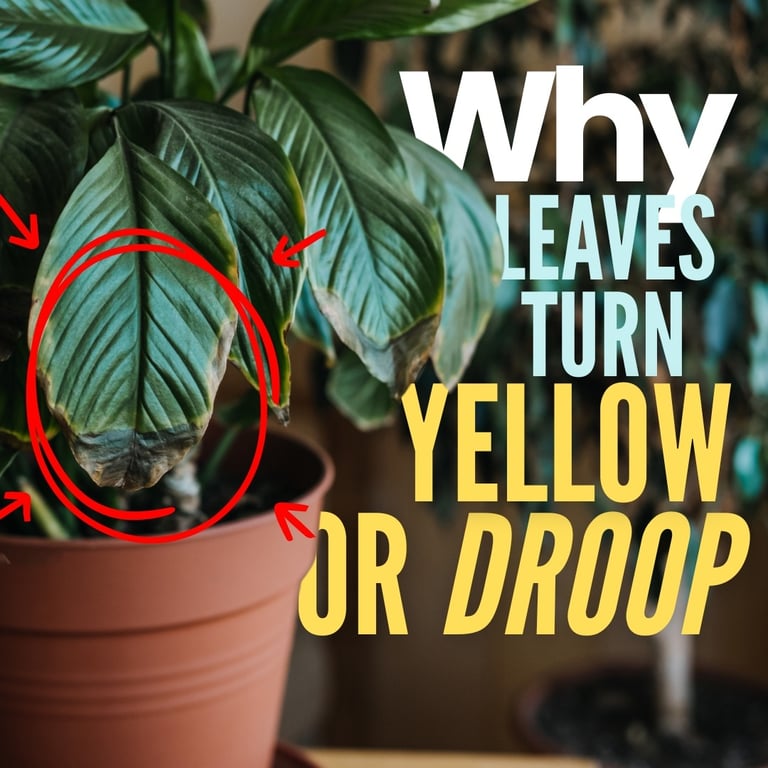Decoding Your Plant's Distress Signals: Why Leaves Turn Yellow, Brown, or Droop
6/23/20253 min read


1. Watering Imbalances: The Foremost Cause
Watering issues are arguably the most frequent culprits behind leaf discoloration and wilting. Both overwatering and underwatering can manifest in similar-looking symptoms, making accurate diagnosis essential.
Overwatering: Characterized by yellow, mushy leaves, often accompanied by drooping. This occurs when the roots are deprived of oxygen due to persistently saturated soil, leading to root rot.
Solution: Always assess soil moisture before watering. Insert your finger approximately two inches into the soil; water only when it feels dry. Ensure your plant pots have adequate drainage holes, and never allow pots to sit in standing water. If root rot is suspected (mushy, foul-smelling roots), consider repotting into fresh, well-draining soil.
Underwatering: Typically presents as crispy brown edges or tips on leaves, with overall drooping. This indicates insufficient moisture reaching the foliage, causing cellular dehydration.
Solution: Water thoroughly until water begins to drain from the bottom of the pot. Establish a consistent watering schedule, but always prioritize checking the soil's dryness. For severely dehydrated plants, consider bottom watering by placing the pot in a saucer of water for 20-30 minutes to allow capillary action to rehydrate the soil.
2. Light Exposure: Striking the Right Balance
Light is fundamental for photosynthesis and overall plant health. Both insufficient and excessive light can negatively impact leaf appearance.
Insufficient Light: Symptoms include overall yellowing of lower leaves, leggy or stretched growth, and a noticeable lack of new growth. The plant is attempting to conserve energy by shedding older leaves and reaching for light.
Solution: Relocate your plant to a brighter position. For most indoor plants, "bright, indirect light" is optimal, meaning a spot near a window but shielded from direct, intense sunlight that can scorch leaves.
Excessive Light: Manifests as scorched brown patches or bleached-looking leaves. This indicates sunburn, common in plants exposed to too much direct sun.
Solution: Move the plant further from the window or use sheer curtains to diffuse the intensity of direct sunlight.
3. Humidity Levels: Addressing Dry Air
Many popular indoor plants originate from tropical environments and thrive in high humidity.
Low Humidity: Often visible as crispy brown tips or edges on leaves, even when watering is adequate. Dry air causes rapid moisture loss from the leaves.
Solution: Increase ambient humidity. Group plants together to create a localized humid microclimate, use a pebble tray (a tray with pebbles and water, ensuring the pot does not sit in the water), or consider using a small room humidifier, especially during dry seasons or when heating/air conditioning systems are active.
4. Nutrient Deficiencies: When Your Plant Needs Sustenance
While less common than watering issues, nutrient imbalances can also affect leaf health.
General Yellowing of Older Leaves (especially lower ones) with Stunted Growth: Often points to a nitrogen deficiency.
Yellowing Between Leaf Veins (while veins remain green): Commonly indicates deficiencies in magnesium or iron.
Solution: Fertilize your plants regularly during their active growing season (typically spring and summer) using a balanced liquid fertilizer, adhering strictly to the product's instructions. Avoid over-fertilization, as this can lead to root burn. Periodically flush the soil with plain water to prevent mineral salt buildup.
5. Pest Infestations: Unwanted Visitors
Tiny pests can cause significant damage by feeding on plant sap, leading to various leaf symptoms.
Sticky Residue, Fine Webbing, Mottled Yellow Spots, Deformed New Growth, or Small Bumps: These are indicative signs of common houseplant pests such as spider mites, mealybugs, aphids, or scale insects.
Solution: Regularly inspect your plants for signs of pests. Immediately isolate any affected plants. Gently wipe leaves with a damp cloth or a mild insecticidal soap solution. Neem oil is also an effective organic treatment. Repeat applications are often necessary to break pest life cycles.
6. Environmental Stressors: Temperature and Transplant Shock
Sudden environmental changes or the stress of repotting can also cause leaf problems.
Sudden Drooping and Yellowing: Can result from rapid temperature fluctuations (e.g., cold drafts, proximity to heating/cooling vents) or the stress of transplant shock after repotting.
Solution: Position plants away from extreme temperature variations. When repotting, handle the plant gently and allow it time to acclimate to its new environment.
Key Take Out
Your plant's leaves serve as vital indicators of its health. By carefully observing these changes and understanding the underlying causes, you can effectively diagnose issues and implement the necessary adjustments to ensure your indoor plants flourish. Proactive care and a keen eye will empower you to become a more successful indoor gardener.
Have you noticed your once vibrant indoor plant displaying an unwelcome change in its foliage? Yellowing, browning, or drooping leaves are common distress signals from your plant, indicating that something in its environment or care routine needs adjustment. Understanding these signs is crucial for maintaining a healthy and thriving indoor plant collection.
This article will delve into the primary reasons behind these common leaf issues, providing accurate insights and actionable advice to help you diagnose and remedy the problems your plants may be facing.
Found EnviroCare
Expert guidance for your agricultural needs.
Contact
info@foundenviro.com
0420 354 157
© 2024. All rights reserved.
Powered by Logos Creative Solutions
ABN: 99412409221
